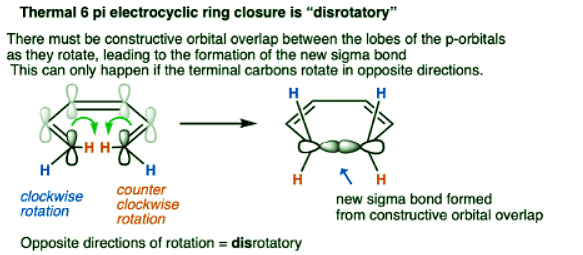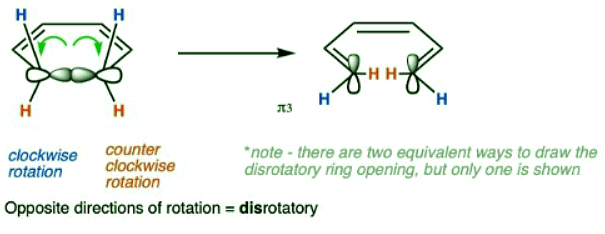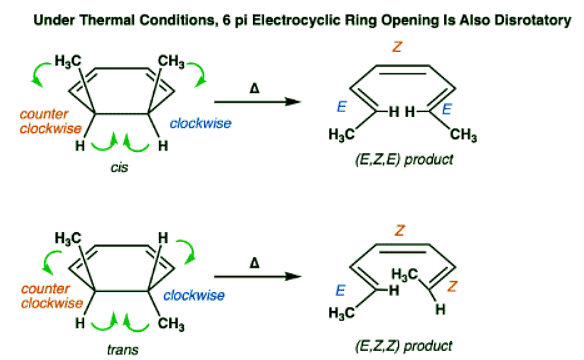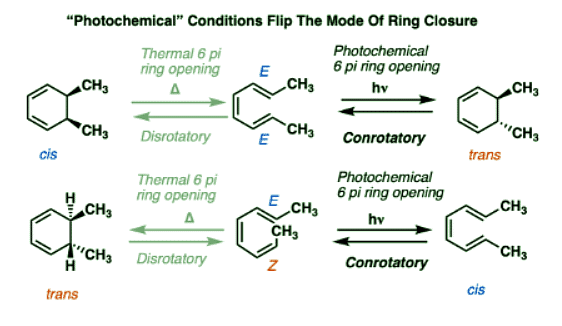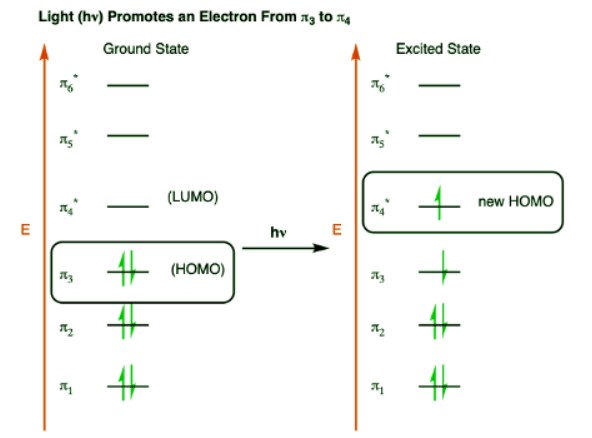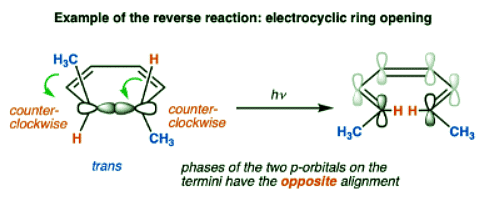UPSC Exam > UPSC Notes > Chemistry Optional Notes for UPSC > Electrocyclic Ring Opening And Closure
Electrocyclic Ring Opening And Closure | Chemistry Optional Notes for UPSC PDF Download
Introduction
- In the last post we introduced electrocyclic ring opening and closure, with conjugated systems of two pi bonds (4 pi electrons). We saw that systems with 4pi electrons undergo “conrotatory” ring closure (and opening) under thermal conditions, and “disrotatory” ring closure (and opening) under photochemical conditions. [We’ll re-introduce those terms in the article below]
- So what happens if we add an extra pi bond to the system, giving us 6 pi-electrons? How does this change things?
- In case you want to skip right to the answer, here’s the short summary.

- Electrocyclic ring-closing and ring opening in 6 pi systems occur in exactly the opposite sense of those in 4 pi systems.
6 pi Thermal Electrocyclic Ring Opening and Closing
- So when we say, a “4 pi” , “6 pi”, or even “n-pi” system, what’s meant by that?
- What we mean is a system of 4, 6 or even “n” atoms bearing p-orbitals able to overlap (“conjugate”) such that a set of 4, 6, or “n” pi molecular orbitals is formed. [See: Conjugation and Resonance]. Since each pi-bond is comprised of two adjacent p orbitals, a molecule with three conjugated pi bonds results in a “pi system” containing 6 pi molecular orbitals.
- Let’s start with the simplest possible 6 pi example that can undergo electrocyclic ring closure: (Z)- hexatri-1,3,5-ene. When this triene is heated, a new species is formed that looks like this:
 Note: this wouldn’t this work for the E isomer. Why not? [See Note 1]
Note: this wouldn’t this work for the E isomer. Why not? [See Note 1] - Note the bonds that form and break here. We’re breaking 3 C-C pi bonds and forming two C-C pi bonds along with a sigma bond.
- The reverse of electrocyclic ring-closure is electrocyclic ring-opening. Heating 1,3-cyclohexadiene will result in at least some (Z)- hexa-1,3,5-triene:

- Note that the bonds that form and break here are the exact opposite than those found in the forward reaction.
- Both electrocyclic ring-opening and ring-closure proceed in a concerted fashion (with no intermediate) and pass through a common transition state. These reactions belong to a class of concerted reactions with cyclic transition states known as pericyclic reactions, which includes the Diels-Alder, the Cope and Claisen rearrangements, and many others.
- Since the reactions are reversible and pass through the same transition state, we can also draw it up as an equilibrium.

- Note 2 about the equilibrium shown here.
Going “Under The Hood” of 6-π Electrocyclic Ring Closure: Identifying The Highest-Occupied Molecular Orbital (HOMO)
- If you look at the bonds formed / bonds broken table, you’ll see that there’s a net destruction of one pi bond and net formation of one sigma bond.
- So what’s actually going on when hexatriene is being converted to 1,3 cyclohexadiene?
- Well, the new sigma bond is formed from the overlap of two p-orbitals as the ends of the hexatriene pi system (carbon 1 and carbon 6) rotate, and the hybridization of these carbons changes from sp2 to sp3. (We’ll get to this in a second).
- The pi molecular orbital involved in this transformation will be the one in which the electrons are the most loosely-held, or in other words, those of highest energy.
- What are the highest-energy electrons in this case? The electrons in the highest-energy molecular orbital (HOMO for short).
- So how do we know what the HOMO looks like? Glad you asked.
- The pi molecular orbitals of 1,3,5 hexatriene look like this:

- That’s a lot to absorb! Thankfully, for our purposes, we don’t need to use all the molecular orbitals of 1,3,5 hexatriene in this instance.
- What we really care about here is the highest-energy (most loosely-held) electrons; the electrons in the highest-occupied molecular orbital (HOMO). In hexatriene, that’s π3, which we’ll draw out below:

- We can simplify things even further. For the purposes of forming the new sigma bond, we’re only going to concern ourselves with the orbitals on C1 and C6, since these are the orbitals involved in forming the new sigma bond.

- Now we can map this on to 1,3,5 hexatriene drawn in the conformation where the reaction will occur.

- Now what?
Question for Electrocyclic Ring Opening And ClosureTry yourself: Which mode of bond formation occurs when the lobes of the orbitals on each termini have the same phase?View Solution
Disrotatory and Conrotatory Ring Closure: The Importance of “Orbital Symmetry”
- In order for the new sigma bond to form, C1 and C6 must rotate such that there is constructive overlap orbitals. They must have the same phase.
- In a 6 pi system like 1,3,5 hexatriene, the orbitals on each of the termini (C1 and C6) each have their phases aligned in the same direction (they are arbitrarily drawn with the “shaded” lobe pointing up, but it would work just as well if they were both drawn with the shaded lobes pointing down). [If you like, you can call this a “symmetric” orientation; the term “orbital symmetry” is generally used to refer to the relative orientation of these lobes.]
- Sigma bond formation can thus be achieved if one carbon rotates clockwise and the other counter-clockwise. This is referred to as a disrotatory mode of bond formation.

- What if they rotate in the same direction? Since the lobes are of opposite phase, this results in destructive orbital overlap and a sigma bond cannot be formed. This mode of bond rotation is called, “conrotatory“.
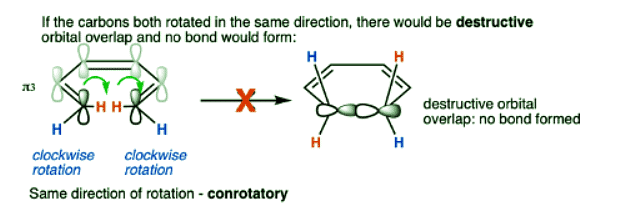
What About Electrocyclic Ring Opening?
- Imagine making a movie of electrocyclic ring closure based on what we just saw.
- Now imagine running that movie in reverse.
- What I’ve just described – the reverse of electrocyclic closure – is electrocyclic ring opening.
- Electrocyclic ring opening and electrocyclic ring closure share the same transition state, so everything that applies to electrocyclic ring closure in the forward direction applies equally to electrocyclic ring opening (the reverse direction).
- Electrocyclic ring opening under thermal conditions for a 6 pi system must occur in such a way that the sigma bond ruptures so as to regenerate the HOMO (π 3) of 1,3,5 hexatriene. So it must also be disrotatory.

- Note 4 that in this figure the blue hydrogens are shown rotating “outward”. Would it work if the blue hydrogens were rotating “inward” as well? Yes, since that still counts as “disrotatory”. For each disrotatory and conrotatory mode, there are generally two possibilities (inward/outward). In this article, for brevity, we’re only going to show one.
Electrocyclic Reactions Are Stereospecific
- So far, we’ve discussed “conrotatory” and “disrotatory” but haven’t really described any situations where the stereochemistry would come into play.
- We’re now ready to see what happens when there are substituents on the end carbons of a 6 pi system like 1,3,5 hexatriene.
- Here are two examples from the chemistry literature. Try to confirm for yourself that these ring closures are indeed disrotatory.

- See how flipping the geometry about one double bond from E to Z results in flipping the geometry of the product?
- Electrocyclic reactions are yet another example of a stereospecific reaction. From IUPAC: A reaction is termed stereospecific if starting materials differing only in their configuration are converted into stereoisomeric products. That’s true here, since the starting materials and products are each stereoisomers (diastereomers) of each other.
- Electrocyclic ring opening also occurs in the disrotatory mode:

- Figuring out the mode of rotation (disrotatory or conrotatory) can take some time and practice. It’s helpful to imagine looking at the molecule from the front, and tracing the path of each substituent as they go from starting material to product. Some practice quizzes are included at the bottom of the post so you can gain some more experience with these types of questions.
Question for Electrocyclic Ring Opening And ClosureTry yourself: What is the effect of ultraviolet light on electrocyclic ring closure and opening?View Solution
Electrocyclic Ring Closure (And Opening) Under “Photochemical” Conditions
- As we saw in the 4pi system, it’s also possible to induce electrocyclic ring opening and closure through the influence of ultraviolet light (hν ).
- However, the mode of rotation is different. In the 6pi system, we saw (above) that heating the system resulted in disrotatory ring closure.
- Under photochemical conditions, the mode of ring closure occurs in the opposite direction.

- These reactions are example of conrotatory ring closure, where each carbon on the terminus rotates in the same direction.
Why might ultraviolet light affect these reactions?
- Recall that in our post on UV-Vis spectroscopy [See: Introduction to UV-Vis Spectroscopy], we saw that UV (and visible) light can promote electrons in pi systems from their highest occupied molecular orbital (HOMO) to the lowest-unoccupied molecular orbital (LUMO).
- In effect, for hexatriene, this would be a transition from pi3 (the HOMO) to pi4 (the LUMO) which effectively becomes the “new” HOMO.

- That means that if we’re looking at an electrocyclic reaction under these conditions, we need to do the analysis based on π4 instead of π3.
- And the orbital symmetry of π4 is different. Let’s overlay π4 on 1,3,5-hexatriene. Then we’re back to a situation where the orbitals on the termini are antisymmetric – just as in the thermal 4 pi case.
- Therefore we should expect to (and do!) see conrotatory ring closure.

- Photochemical electrocyclic ring opening in 6 pi systems is also observed, and is likewise conrotatory.

- You’re probably familiar with one example of this reaction, even if you don’t know it.
- At some point, your parents probably told you to play outside so you could “get your vitamin D”.
- What your parents didn’t tell you was that you needed the UV light (290-330 nm) to activate a 6 pi conrotatory electrocyclic ring opening to convert 7-dehydrochloresterol into Previtamin D3:

- I pass this on to you, so you can tell your future children what’s really going on when they play outside.
Note 3: There’s a second pericyclic reaction involved in the formation of Vitamin D3 from “Previtamin D3” but we’re not going to go there today.
Summary: 6 pi Electrocyclic Ring Opening and Closure
- That’s probably enough for one article. We can summarize the key patterns in a nice little table.

- From the Chem 206 notes of Prof. David Evans comes a useful concept called the “toggle” algorithm.
- Since the mode of rotation “flips” when going from thermal to photochemical conditions, or from adding 2 p-orbitals to the pi system, you only need to remember one of these cases, and you can derive all the others by using the “toggle” algorithm.
Notes
- Note 1: If the C3-C4 double bond was trans, the two termini wouldn’t meet.
- Note 2: I’ve drawn the equilibrium arrows as “equal” here, but that shouldn’t be meant to imply that the equilibrium constant is 1. Generally, the ring closure should be favored over ring opening since C-C sigma bonds (about 80 kcal/mol) are stronger than C-C pi bonds (about 60 kcal/mol).
- Note 3: “Pre-Vitamin D3” is converted into Vitamin D3 through an antarafacial 1,7 hydrogen shift, which we might get into in a later post. This site covers the topic nicely.
- Note 4: In the interest of space, we didn’t really go into the fact that each mode (“conrotatory” and “disrotatory”) can occur in two directions, e.g. for a conrotatory process, both carbons can rotate clockwise or both can rotate counterclockwise. Only one of the two options is shown here. In the previous post we spent a bit more time discussing the two possibilities. The term “torqueselectivity” refers to the propensity of a molecule to favor one of the directions over another, or to use the actual definition: “the preference for inward or outward rotation of substituents in conrotatory or disrotatory electrocyclic reactions”.
The document Electrocyclic Ring Opening And Closure | Chemistry Optional Notes for UPSC is a part of the UPSC Course Chemistry Optional Notes for UPSC.
All you need of UPSC at this link: UPSC
FAQs on Electrocyclic Ring Opening And Closure - Chemistry Optional Notes for UPSC
| 1. What is the concept of 6 pi Thermal Electrocyclic Ring Opening and Closing? |  |
Ans. 6 pi Thermal Electrocyclic Ring Opening and Closing refers to a type of reaction in organic chemistry where a ring structure opens or closes through the rearrangement of pi bonds. In this process, the ring undergoes a thermal reaction, meaning it occurs under normal temperature and pressure conditions.
| 2. How is the Highest-Occupied Molecular Orbital (HOMO) identified in 6-π Electrocyclic Ring Closure? |  |
Ans. The Highest-Occupied Molecular Orbital (HOMO) in 6-π Electrocyclic Ring Closure can be identified by analyzing the molecular orbitals of the reactant and product species. The HOMO is the molecular orbital with the highest energy level that contains electrons. By comparing the HOMO of the reactant with that of the product, one can determine the changes in electron density during the ring closure process.
| 3. What is the significance of "orbital symmetry" in disrotatory and conrotatory ring closure? |  |
Ans. "Orbital symmetry" plays a crucial role in disrotatory and conrotatory ring closure reactions. In these reactions, the direction of rotation of the pi bonds determines the outcome of the reaction. Disrotatory closure involves the pi bonds rotating in opposite directions, while conrotatory closure involves the pi bonds rotating in the same direction. The symmetry of the molecular orbitals must match the symmetry requirements for these rotations to occur, influencing the stereochemistry and product formation.
| 4. How does electrocyclic ring opening differ from ring closure? |  |
Ans. Electrocyclic ring opening is the reverse process of electrocyclic ring closure. While ring closure involves the formation of a cyclic structure by rearranging pi bonds, ring opening refers to the breaking of a cyclic structure by breaking the pi bonds. In terms of mechanism and stereochemistry, ring opening follows similar principles as ring closure but in the opposite direction.
| 5. Are electrocyclic reactions stereospecific? |  |
Ans. Yes, electrocyclic reactions are stereospecific, meaning the stereochemistry of the reactant determines the stereochemistry of the product. The direction of rotation of the pi bonds during ring closure or opening is determined by the initial stereochemistry of the reactant molecule. This stereochemical information is retained in the product, resulting in a stereospecific reaction.

|
Explore Courses for UPSC exam
|

|
Signup for Free!
Signup to see your scores go up within 7 days! Learn & Practice with 1000+ FREE Notes, Videos & Tests.
Related Searches
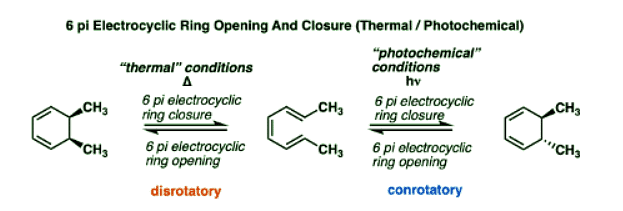
 Note: this wouldn’t this work for the E isomer. Why not? [See Note 1]
Note: this wouldn’t this work for the E isomer. Why not? [See Note 1] 





